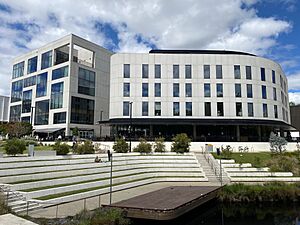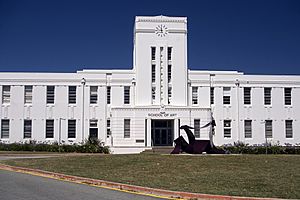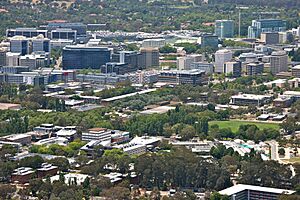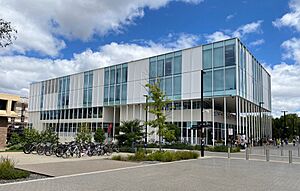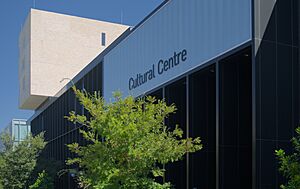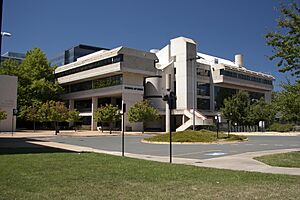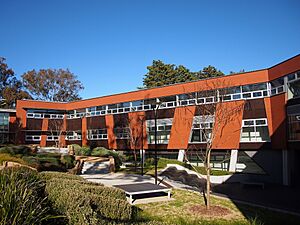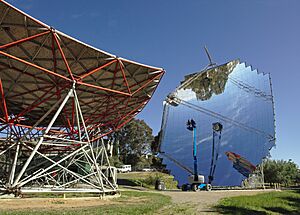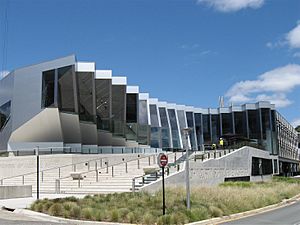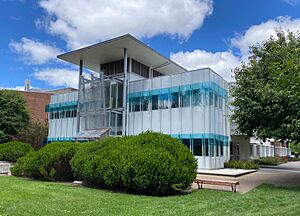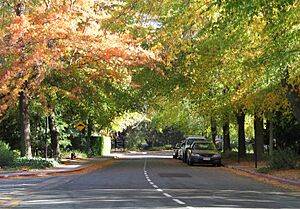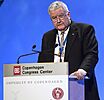Australian National University facts for kids
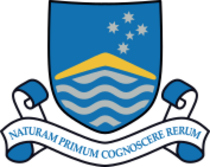
|
|
| Motto |
Latin: Naturam Primum Cognoscere Rerum
|
|---|---|
|
Motto in English
|
"First to learn the nature of things" |
| Type | Public national research university |
| Established | 1 August 1946 |
|
Academic affiliation
|
|
| Endowment | A$346.25 million (2022) |
| Budget | A$1.36 billion (2022) |
| Chancellor | Julie Bishop |
| Vice-Chancellor | Genevieve Bell |
| Students | 17,380 (2021) |
| Undergraduates | 10,252 (2021) |
| Postgraduates | 7,128 (2021) |
| Location |
Canberra
,
,
2600
,
35°16′40″S 149°07′14″E / 35.2778°S 149.1205°E |
| Campus | Urban, parkland and regional, 145 hectares (358.3 acres) |
| Colours | ANU Gold |
| Nickname | Owls |
|
Sporting affiliations
|
|
| Mascot | Owl |
 |
|
The Australian National University (ANU) is a top public university in Canberra, Australia's capital city. It's known for its strong focus on research. The main campus in Acton has seven colleges for teaching and research. It also hosts several national academies and institutes.
ANU was started in 1946 by the Parliament of Australia, making it unique. It grew from Canberra University College, which began in 1929. ANU has many students, including those studying for their first degree and those doing advanced studies. Many famous people have studied or worked at ANU. This includes six Nobel Prize winners and many Rhodes scholars. It has also educated two former prime ministers and many leaders in government.
Contents
Discovering ANU's Past
How ANU Began
People wanted a national university in Australia as early as 1900. When Canberra was chosen as the capital in 1908, land was set aside for ANU. World War II delayed its creation, but the Australian National University Act 1946 officially started the university on August 1, 1946.
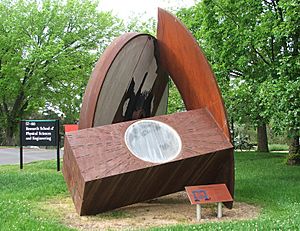
Important Australian scholars came back from overseas to join ANU. These included Sir Howard Florey, who helped develop penicillin, and Sir Mark Oliphant, a nuclear physicist. Sir Douglas Copland became the first Vice-Chancellor, and former Prime Minister Stanley Bruce was the first Chancellor. ANU first had four main research areas: Physical Sciences, Social Sciences, Pacific Studies, and Medical Research.
The first student and staff housing, University House, opened in 1954. Mount Stromlo Observatory, an astronomy site, joined ANU in 1957. The main ANU Library buildings opened in 1963. The Australian Forestry School also became part of ANU in 1965.
Canberra University College Joins ANU
Canberra University College (CUC) was the first higher education place in Canberra, starting in 1929. It offered its first courses in 1930. CUC was linked with the University of Melbourne, which granted its degrees. Famous teachers at CUC included historian Manning Clark and poet A. D. Hope.
In 1960, CUC became part of ANU. It was renamed the School of General Studies. It first offered courses in arts, economics, law, and science. Later, it added studies in Asian cultures and engineering. Bruce Hall, the first living space for undergraduate students, opened in 1961.
ANU Today
The Canberra School of Music and the Canberra School of Art joined together in 1988. They became the Canberra Institute of the Arts. In 1992, this institute became part of ANU as the ANU Institute of the Arts.
ANU started its Medical School in 2002. In 2003, the Canberra bushfires badly damaged the Mount Stromlo Observatory. ANU astronomers now use the Siding Spring Observatory for their research.
In 2013, ANU graduate Graham Tuckwell made the largest university donation in Australian history. He gave $50 million for student scholarships. ANU has also been a leader in encouraging universities to stop investing in fossil fuel companies.
ANU has exchange programs with many universities around the world. These include schools in Asia, North America, and Europe. In 2017, there was a cyberattack on ANU computers.
Exploring ANU's Campuses
The main ANU campus is in Acton, Canberra. It covers about 145 hectares (358 acres) of parkland. The campus has many historic buildings. Over 40 buildings are recognized for their historical importance.
ANU is known for its green campus with over 10,000 trees. It won an award for being a sustainable campus in 2009. Four of Australia's five main academic societies are based at ANU. The National Museum of Australia and CSIRO are also very close to the campus.
ANU has other locations too. These include Mount Stromlo Observatory and Siding Spring Observatory for astronomy. It also has a campus at Kioloa on the New South Wales South Coast.
Drill Hall Gallery
The Drill Hall Gallery is in an old drill hall from the 1940s. It was used to train soldiers during World War II. In 1984, it was turned into an art gallery. ANU took over the hall in 1992 to show its own art collection and host temporary exhibitions.
The gallery has four exhibition spaces. It hosts both national and international art shows. A large painting by Sidney Nolan called Riverbend is always on display there.
How ANU is Organized
University Council
ANU is managed by a Council with 15 members. This includes the Chancellor and Vice-Chancellor. Julie Bishop, a former Foreign Minister, became Chancellor in January 2020. Genevieve Bell, a cultural anthropologist, became Vice-Chancellor in January 2024.
Academic Colleges
In 2006, ANU was reorganized into seven Colleges. Each college handles both teaching and research.
Arts, Humanities and Social Sciences
This college studies many subjects like History, Philosophy, Sociology, Politics, International Relations, and Demography. It also has schools for Archaeology, Anthropology, Art & Design, and Literature, Languages and Linguistics. The ANU School of Music is also part of this college. In 2017, ANU was ranked very highly in the world for politics and social policy.
Asia and the Pacific
This college is a special center for studying Asian and Pacific studies and languages. It has many experts in these areas. It includes the Crawford School of Public Policy, which focuses on public policy. It also has schools for culture, history, languages, and international affairs in Asia and the Pacific. This college also hosts centers for studying China, Japan, Korea, and other regions.
Business and Economics
This college has four schools that teach and research economics, finance, accounting, actuarial studies, statistics, marketing, and management. It has research centers for social policy, audit, economic history, and information systems.
Systems and Society
This college looks at how systems, technology, and the physical world connect with society. It includes the Australian National Centre for the Public Awareness of Science, the Fenner School of Environment & Society, and schools for Computing, Cybernetics, and Engineering. ANU is home to a major computing facility called the National Computational Infrastructure National Facility.
Law, Governance and Policy
This college includes the ANU Law School. It focuses on legal research and teaching. It has centers for commercial law, international law, public law, and environmental law. It offers degrees like the Bachelor of Laws (LL.B.) and Juris Doctor (J.D.). It is one of Australia's oldest law schools and is highly ranked globally.
Science and Medicine
This college includes research schools for Astronomy & Astrophysics, Biology, Chemistry, Earth Sciences, and Physics. Early research at ANU focused on nuclear physics. Brian Schmidt, an astrophysicist at Mount Stromlo Observatory, won the 2011 Nobel Prize for Physics.
The college also includes the John Curtin School of Medical Research (JCSMR) and the ANU Medical School. JCSMR was started in 1948. Three more Nobel Prizes have been won for research done at JCSMR.
Academic Life at ANU
Libraries and Archives
The ANU library started in 1948. It has over 2.5 million books and other items across six branches. The Chifley and Hancock libraries are open 24 hours a day for students and staff.
Student Costs and Support
For international students, tuition fees vary depending on the program. Australian students may get a government-supported place, which lowers their costs. They can also get student loans from the government. The university offers many scholarships to help students with their fees.
University Rankings
ANU is consistently ranked among the top universities in Australia and the world. In 2024, it was ranked #57 globally when combining different major rankings.
- In the 2026 Quacquarelli Symonds World University Rankings, ANU was ranked #32 globally.
- In the Times Higher Education World University Rankings 2025, it was ranked #73 globally.
- In the 2024 Academic Ranking of World Universities, ANU was ranked in the #101–150 range globally.
Student Success
Surveys show that ANU graduates are highly sought after by employers. In 2023, 84.2% of employers were happy with ANU graduates. Also in 2023, 80.7% of undergraduate students and 88.5% of postgraduate students found full-time jobs after graduating.
Student Life at ANU
Student Groups
The Australian National University Students' Association (ANUSA) represents undergraduate students. The Australian National University Union helps manage services like food and shops for all students.
Student Media
Woroni
Woroni is a student publication at ANU. It started in 1947. The name Woroni comes from an Indigenous Australian word meaning "mouthpiece." It is published regularly as a magazine and covers news and opinions. An independent student group runs Woroni. They also have an online radio station and a video production team. Old issues of Woroni are available online.
ANU Observer
ANU Observer is another student news publication at ANU. It started in 2017 as an online news site. It covers campus news, student life, arts, culture, and sports. ANU Observer also produces a weekly podcast.
Places to Live
Eleven on-campus residential halls are linked with ANU. These include Bruce Hall, Burgmann College, and John XXIII College. They offer housing for both undergraduate and postgraduate students. There are also four UniLodge residences near campus.
Students have sometimes protested about rent increases and concerns about student well-being in the residential halls.
Famous People from ANU
Notable Alumni
Many ANU graduates have become important leaders. Bob Hawke and Kevin Rudd, both former Australian Prime Ministers, studied at ANU. Other senior politicians like Annastacia Palaszczuk and Barry O'Farrell also attended. Many Australian ambassadors and heads of government departments are ANU alumni. International leaders like the Prime Minister of the Solomon Islands Gordon Darcy Lilo and former Indonesian Foreign Minister Marty Natalegawa also studied here.
Other famous alumni include High Court of Australia judges, journalists, and business leaders.
- Notable alumni of ANU
-
Bob Hawke, 23rd Prime Minister of Australia.
-
Kevin Rudd, 26th Prime Minister of Australia.
-
Annastacia Palaszczuk, former Premier of Queensland.
-
Barry O'Farrell, former Premier of New South Wales.
-
Lt. Gen. David Morrison, former Australian Chief of Army.
Academics and Staff
Many famous academics have taught at ANU. These include Mark Oliphant, who helped discover tritium, and Howard Florey, a Nobel Prize winner for his work on penicillin. Nobel Prizes have also been awarded to other ANU faculty members like John Eccles, Peter Doherty, Rolf M. Zinkernagel, and Brian Schmidt.
- Notable past and present staff of ANU
-
H.C. Coombs, first Governor of the Reserve Bank of Australia.
-
Mark Oliphant, known for his work in nuclear physics.
-
Howard Florey, Nobel Prize winner for developing penicillin.
-
Gareth Evans, former Australian Minister for Foreign Affairs.
-
Brian Schmidt, Nobel Prize winner and former ANU Vice-Chancellor.
Honorary Doctorates
Many important people have received honorary doctorates from ANU. These include former Australian officials like Robert Menzies and Angus Houston. Famous artists like Sidney Nolan and international figures like Nelson Mandela and Aung San Suu Kyi have also received this honor.
See also
 In Spanish: Universidad Nacional Australiana para niños
In Spanish: Universidad Nacional Australiana para niños
- List of universities in Australia


